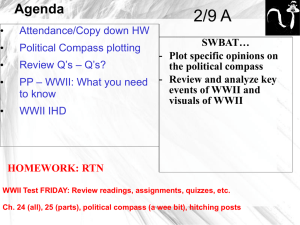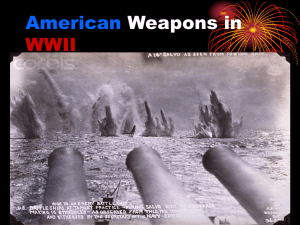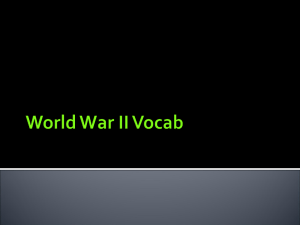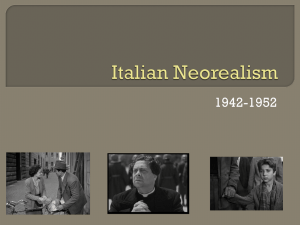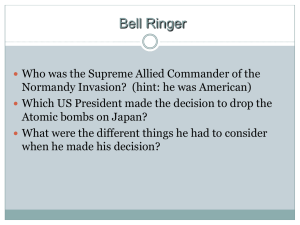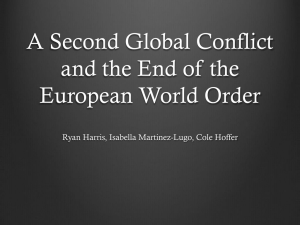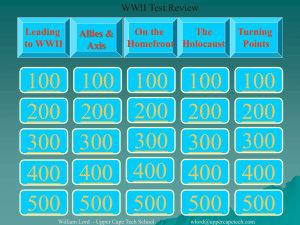Introduction, Cryptography before World War II
advertisement
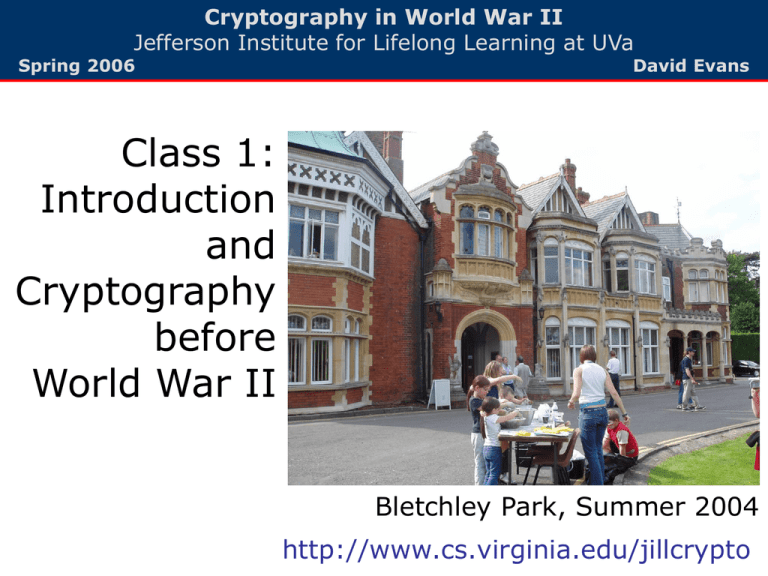
Cryptography in World War II
Jefferson Institute for Lifelong Learning at UVa
Spring 2006
David Evans
Class 1:
Introduction
and
Cryptography
before
World War II
Bletchley Park, Summer 2004
http://www.cs.virginia.edu/jillcrypto
Overview
1. Introduction, Pre-WWII cryptology
2. Lorenz Cipher (Fish)
–
–
Used by Nazis for high command messages
First programmable electronic computer built
to break it
3. Enigma Cipher
–
–
Used by German Navy, Army, Air Force
Broken by team including Alan Turing
4. Post-WWII
–
–
Modern symmetric ciphers
Public-Key Cryptography
JILL WWII Crypto Spring 2006 - Class 1: Introduction
2
Menu
• Introduction to Cryptology
– Terminology
– Principles
– Brief history of 4000 years of Cryptology
• Cryptology before World War II
– A simple substitution cipher
– [Break]
– Breaking substitution cipher
– Vigenère Cipher
JILL WWII Crypto Spring 2006 - Class 1: Introduction
3
Jefferson Wheel Cipher
JILL WWII Crypto Spring 2006 - Class 1: Introduction
4
What is cryptology?
• Greek: “krypto” = hide
• Cryptology – science of hiding
– Cryptography, Cryptanalysis – hide meaning of a
message
– Steganography, Steganalysis – hide existence of a
message
• Cryptography – secret writing
• Cryptanalysis – analyzing (breaking) secrets
Cryptanalysis is what attacker does
Decipher or Decryption is what legitimate receiver
does
JILL WWII Crypto Spring 2006 - Class 1: Introduction
5
Cryptology and Security
Cryptology is a branch of
mathematics.
Security is about people.
Attackers try find the weakest link. In
most cases, this is not the mathematics.
JILL WWII Crypto Spring 2006 - Class 1: Introduction
6
Introductions
Insecure Channel
Plaintext
Alice
Encrypt
Ciphertext
Decrypt
Eve
(passive attacker)
JILL WWII Crypto Spring 2006 - Class 1: Introduction
Plaintext
Bob
7
Introductions
Insecure Channel
Plaintext
Alice
Encrypt
Ciphertext
Decrypt
Malice
(active attacker)
JILL WWII Crypto Spring 2006 - Class 1: Introduction
Plaintext
Bob
8
Cryptosystem
Ciphertext = E(Plaintext)
Required property: E must be invertible
Plaintext = D(Ciphertext)
Desired properties:
Without knowing D must be “hard” to invert
E and D should be easy to compute
Possible to have lots of different E and D
JILL WWII Crypto Spring 2006 - Class 1: Introduction
9
“The enemy knows the
system being used.”
Claude Shannon
JILL WWII Crypto Spring 2006 - Class 1: Introduction
10
Kerckhoff’s Principle
• French handbook of military cryptography,
1883
• Cryptography always involves:
– Transformation
– Secret
• Security should depend only on the key
• Don’t assume enemy won’t know algorithm
– Can capture machines, find patents, etc.
– Too expensive to invent new algorithm if it might
have been compromised
Axis powers often forgot this
JILL WWII Crypto Spring 2006 - Class 1: Introduction
11
http://monticello.org/jefferson/wheel
cipher/
JILL WWII Crypto Spring 2006 - Class 1: Introduction
12
Symmetric Cryptosystem
Ciphertext = E (K, Message)
Message = D (K, Ciphertext)
Desired properties:
1.Kerckhoff’s: secrecy depends only on K
2.Without knowing K must be “hard” to invert
3.Easy to compute E and D
All cryptosystems until 1970s were like this.
Asymmetric cryptosystems allow encryption and
decryption keys to be different.
JILL WWII Crypto Spring 2006 - Class 1: Introduction
13
Really Brief History
First 4000 years
Vigenère
Babbage breaks Vigenère;
Kasiski (1863) publishes
Cryptographers
Alberti – first polyalphabetic cipher
monoalphabetics
Cryptanalysts
3000BC
al-Kindi - frequency analysis
900
JILL WWII Crypto Spring 2006 - Class 1: Introduction
1460
1854
14
Really Brief History - last 100+ years
Mauborgne – one-time pad
Quantum Crypto
?
Enigma adds rotors, stops repeated key
Linear, Differential
Cryptanalysis
Feistel block cipher, DES
Turing’s loop attacks,
Colossus
Public-Key
1978
Rejewski repeated
message-key attack
Cryptanalysts
Mechanical ciphers - Enigma
Cryptographers
1854
1918
1939
1945
1973
1895 – Invention of Radio
JILL WWII Crypto Spring 2006 - Class 1: Introduction
15
Themes
• Arms race: cryptographers vs. cryptanalysts
– Often disconnect between two (e.g., Mary Queen of
Scots uses monoalphabetic cipher long after known
breakable)
• Motivated by war (more recently: commerce)
• Driven by advances in technology,
mathematics
– Linguists, classicists, mathematicians, computer
scientists, physicists
• Secrecy often means advances rediscovered
and mis-credited
JILL WWII Crypto Spring 2006 - Class 1: Introduction
16
Types of Attacks
• Ciphertext-only - How much Ciphertext?
• Known Plaintext - often “Guessed Plaintext”
• Chosen Plaintext (get ciphertext)
– Not as uncommon as it sounds!
•
•
•
•
Chosen Ciphertext (get plaintext)
Dumpster Diving
Social Engineering
“Rubber-hose cryptanalysis”
– Cryptanalyst uses threats, blackmail, torture,
bribery to get the key
JILL WWII Crypto Spring 2006 - Class 1: Introduction
17
Security vs. Pragmatics
• Trade-off between security and effort
– Time to encrypt, cost and size of equipment, key
sizes, change frequency
– One-time pad (1918) offers theoretically
“perfect” security, but unacceptable cost
• Compromises lead to insecurity (class 2)
• Commerce
– Don’t spend $10M to protect $1M
– Don’t protect $1B with encryption that can be
broken for $1M
• Military
– Values (and attacker resources) much harder to
measure
JILL WWII Crypto Spring 2006 - Class 1: Introduction
18
Simple Substitution Cipher
• Substitute each letter based on
mapping
• Key is alphabet mapping:
a J, b L, c B, d R, ..., z F
• How secure is this cipher?
JILL WWII Crypto Spring 2006 - Class 1: Introduction
19
Key Space
• Number of possible keys
26 (ways to choose what a maps to)
* 25 (b can map to anything else)
* 24 (c can map to anything else)
… * 1 (only one choice left for z)
= 26! = 403291461126605635584000000
If every person on earth tried one per second,
it would take 5B years to try them all.
JILL WWII Crypto Spring 2006 - Class 1: Introduction
20
Really Secure?
• Key space gives the upper bound
– Worst possible approach for the
cryptanalyst is to try all possible keys
• Clever attacker may find better
approach:
– Eliminate lots of possible keys quickly
– Find patters in ciphertext
– Find way to test keys incrementally
JILL WWII Crypto Spring 2006 - Class 1: Introduction
21
Monoalphabetic Cipher
“XBW HGQW XS ACFPSUWG FWPGWXF
CF AWWKZV CDQGJCDWA CD BHYJD
DJXHGW; WUWD XBW ZWJFX
PHGCSHF YCDA CF GSHFWA LV XBW
KGSYCFW SI FBJGCDQ RDSOZWAQW
OCXBBWZA IGSY SXBWGF.”
JILL WWII Crypto Spring 2006 - Class 1: Introduction
22
Frequency Analysis
“XBW HGQW XS ACFPSUWG FWPGWXF CF
AWWKZV CDQGJCDWA CD BHYJD DJXHGW;
WUWD XBW ZWJFX PHGCSHF YCDA CF
GSHFWA LV XBW KGSYCFW SI FBJGCDQ
RDSOZWAQW OCXBBWZA IGSY SXBWGF.”
W: 20
C: 11
F: 11
G: 11
“Normal”
e
t
a
JILL WWII Crypto Spring 2006 - Class 1: Introduction
English:
12%
9%
8%
23
Pattern Analysis
“XBe HGQe XS ACFPSUeG FePGeXF CF
AeeKZV CDQGJCDeA CD BHYJD DJXHGe;
eUeD XBe ZeJFX PHGCSHF YCDA CF
GSHFeA LV XBe KGSYCFe SI FBJGCDQ
RDSOZeAQe OCXBBeZA IGSY SXBeGF.”
XBe = “the”
Most common trigrams in English:
the = 6.4%
and = 3.4%
JILL WWII Crypto Spring 2006 - Class 1: Introduction
24
Guessing
“the HGQe tS ACFPSUeG FePGetF CF
AeeKZV CDQGJCDeA CD hHYJD DJtHGe;
eUeD the ZeJFt PHGCSHF YCDA CF
GSHFeA LV the KGSYCFe SI FhJGCDQ
RDSOZeAQe OCthheZA IGSY StheGF.”
S = “o”
JILL WWII Crypto Spring 2006 - Class 1: Introduction
25
Guessing
“the HGQe to ACFPoUeG FePGetF CF
AeeKZV CDQGJCDeA CD hHYJD DJtHGe;
eUeD the ZeJFt PHGCoHF YCDA CF
GoHFeA LV the KGoYCFe oI FhJGCDQ
RDoOZeAQe OCthheZA IGoY otheGF.”
otheGF = “others”
JILL WWII Crypto Spring 2006 - Class 1: Introduction
26
Guessing
“the HrQe to ACsPoUer sePrets Cs
AeeKZV CDQrJCDeA CD hHYJD DJtHre;
eUeD the ZeJst PHrCoHs YCDA Cs
roHseA LV the KroYCse oI shJrCDQ
RDoOZeAQe OCthheZA IroY others.”
“sePrets” = “secrets”
JILL WWII Crypto Spring 2006 - Class 1: Introduction
27
Guessing
“the HrQe to ACscoUer secrets Cs
AeeKZV CDQrJCDeA CD hHYJD DJtHre;
eUeD the ZeJst cHrCoHs YCDA Cs
roHseA LV the KroYCse oI shJrCDQ
RDoOZeAQe OCthheZA IroY others.”
“ACscoUer” = “discover”
JILL WWII Crypto Spring 2006 - Class 1: Introduction
28
Guessing
“the HrQe to discover secrets is
deeKZV iDQrJiDed iD hHYJD DJtHre;
eveD the ZeJst cHrioHs YiDd is
roHsed LV the KroYise oI shJriDQ
RDoOZedQe OithheZd IroY others.”
JILL WWII Crypto Spring 2006 - Class 1: Introduction
29
Monoalphabetic Cipher
“The urge to discover secrets is deeply
ingrained in human nature; even the
least curious mind is roused by the
promise of sharing knowledge
withheld from others.”
- John Chadwick,
The Decipherment of Linear B
JILL WWII Crypto Spring 2006 - Class 1: Introduction
30
Why was it so easy?
• Doesn’t hide statistical properties of
plaintext
• Doesn’t hide relationships in plaintext
(EE cannot match dg)
• English (and all natural languages) is
very redundant: about 1.5 bits of
information per letter (~68% f ltrs r
redndnt)
– Compress English with gzip – about 1:6
JILL WWII Crypto Spring 2006 - Class 1: Introduction
31
How to make it harder?
• Cosmetic
• Hide statistical properties:
– Encrypt “e” with 12 different symbols,
“t” with 9 different symbols, etc.
– Add nulls, remove spaces
• Polyalphbetic cipher
– Use different substitutions
• Transposition
– Scramble order of letters
JILL WWII Crypto Spring 2006 - Class 1: Introduction
32
Ways to Convince
• “I tried really hard to break my cipher, but couldn’t.
I’m a genius, so I’m sure no one else can break it
either.”
• “Lots of really smart people tried to break it, and
couldn’t.”
• Mathematical arguments – key size (dangerous!),
statistical properties of ciphertext, depends on
some provably (or believed) hard problem
• Invulnerability to known cryptanalysis techniques
(but what about undiscovered techniques?)
JILL WWII Crypto Spring 2006 - Class 1: Introduction
33
Vigenère
• Invented by Blaise de Vigenère,
~1550
• Considered unbreakable for 300
years
• Broken by Charles Babbage but kept
secret to help British in Crimean War
• Attack discovered independently by
Friedrich Kasiski, 1863.
JILL WWII Crypto Spring 2006 - Class 1: Introduction
34
Vigenère Encryption
Key is a N-letter string.
EK (P) = C where
Ci = (Pi + Ki mod N) mod Z
(size of alphabet)
E“KEY” (“test”) = DIQD
C0 = (‘t’ + ‘K’) mod 26 = ‘D’
C1 = (‘e’ + ‘E’) mod 26 = ‘I’
C2 = (‘s’ + ‘Y’) mod 26 = ‘Q’
C3 = (‘t’ + ‘K’) mod 26 = ‘D’
JILL WWII Crypto Spring 2006 - Class 1: Introduction
35
12345678901234567890123456789012345678901234567890123456
Plain: ThebiggerboysmadeciphersbutifIgotholdofafewwordsIusually
Key: KEYKEYKEYKEYKEYKEYKEYKEYKEYKEYKEYKEYKEYKEYKEYKEYKEYKEYKE
Cipher: DLCLMEQIPLSWCQYNIASTFOVQLYRSJGQSRRSJNSDKJCGAMBHQSYQEEJVC
7890123456789012345678901234567890123456789012345678901234
Plain: foundoutthekeyTheconsequenceofthisingenuitywasoccasionally
Key: YKEYKEYKEYKEYKEYKEYKEYKEYKEYKEYKEYKEYKEYKEYKEYKEYKEYKEYKEY
Cipher: DYYLNSSDXFOOCIXFOGMXWCAYCXGCYJRRMQSREORSSXWGEQYGAKWGYRYVPW
5678901234567890123456789012345678901234567890123456789
Plain: painfultheownersofthedetectedcipherssometimesthrashedme
Key: KEYKEYKEYKEYKEYKEYKEYKEYKEYKEYKEYKEYKEYKEYKEYKEYKEYKEYK
Cipher: ZEGXJSVXFOSUXIPCSDDLCNIROGROHASTFOVQCSKOXGWIQDLPKWFOHKO
012345678901234567890123456789012345
Plain: thoughthefaultlayintheirownstupidity
Key: YKEYKEYKEYKEYKEYKEYKEYKEYKEYKEYKEYKE
Cipher: XFYYERXFOJYEPRVEWSRRRIGBSUXWRETGNMRI
JILL WWII Crypto Spring 2006 - Class 1: Introduction
Charles Babbage
(quoted in Simon
Singh, The Code
Book)
36
Babbage’s Attack
• Use repetition to guess key length:
Sequence XFO appears at 65, 71,
122, 176.
Spacings = (71 – 65) = 6 = 3 * 2
(122 – 65) = 57 = 3 * 19
(176 – 122) = 54 = 3 * 18
Key is probably 3 letters long.
JILL WWII Crypto Spring 2006 - Class 1: Introduction
37
Key length - Frequency
• Once you know key length, can slice
ciphertext and use frequencies:
L0: DLQLCNSOLSQRNKGBSEVYNDOIOXAXYRSOSGYKY
VZXVOXCDNOOSOCOWDKOOYROEVSRBXENI
Frequencies: O: 12, S: 7,
Ci = (Pi + Ki mod N) mod Z
‘O’ = (‘e’ + K0) mod 26
14 = 5 + 9 => K0 = ‘K’
JILL WWII Crypto Spring 2006 - Class 1: Introduction
Guess O = e
38
Sometimes, not so lucky...
L1:
LMISQITVYJSSSJAHYECYSXOXGWYGJMRRXEGWRPEJXSI
SLIGHTVSXILWHXYXJPERISWTM
S: 9, X: 7; I: 6 guess S = ‘e’
‘S’ = (‘e’ + K1) mod 26
19 = 5 + 14 => K1 = ‘N’
‘X’ = (‘e’ + K1) mod 26
24 = 5 + 19 => K1 = ‘M’
‘I’ = (‘e’ + K1) mod 26
10 = 5 + 5 => K1 = ‘E’
JILL WWII Crypto Spring 2006 - Class 1: Introduction
39
Vigenère Simplification
• Use binary alphabet {0, 1}:
Ci = (Pi + Ki mod N) mod 2
Ci = Pi Ki mod N
• Use a key as long as P:
Ci = Pi Ki
• One-time pad – perfect cipher!
JILL WWII Crypto Spring 2006 - Class 1: Introduction
40
Perfectly Secure Cipher:
One-Time Pad
• Mauborgne/Vernam [1917]
• XOR ():
00=0
01=1
10=1
11=0
aa=0
a0=a
abb=a
• E(P, K) = P K
D(C, K) = C K = (P K) K = P
JILL WWII Crypto Spring 2006 - Class 1: Introduction
41
Why perfectly secure?
For any given ciphertext, all
plaintexts are equally possible.
Ciphertext:
01001
Key1:
01001
Plaintext1:
00000
Key2:
10110
Plaintext2:
11111
JILL WWII Crypto Spring 2006 - Class 1: Introduction
42
Perfect Security Solved?
• Cannot reuse K
– What if receiver has
C1 = P1 K and C2 = P2 K
C1 C2 = P 1 K P2 K
= P1 P2
• Need to generate truly random bit
sequence as long as all messages
• Need to securely distribute key
JILL WWII Crypto Spring 2006 - Class 1: Introduction
43
Next week:
“One-Time” Pads in Practice
• Lorenz Machine
• Nazi high command
in WWII
– Operator errors:
reused key
• Pad generated by 12
rotors
– Not really random
JILL WWII Crypto Spring 2006 - Class 1: Introduction
44
Public Lecture Tonight
• David Goldschmidt, “Communications
Security: A Case History”
– Director of Center for Communications
Research, Princeton
– Enigma and how it was broken
• 7:30pm Tonight
• UVa Physics Building, Room 203
We will cover some of the same
material in the third class.
JILL WWII Crypto Spring 2006 - Class 1: Introduction
45
